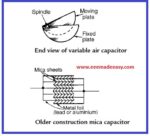Ohms’s law solved Problems
Reference Notes :
What is Ohm’s Law? Ohm’s Law Statement Formula Examples
Ohmmeter- basic principle and working
[Latest]Sub Engineer Electrical KSEB Detailed Syllabus Download PDF| KSEB Sub Engineer Syllabus
Basic Electric Circuits MCQ Questions
Problem 1:
A current of 0.5 A is flowing through the resistance of 10Ω.Find the potential difference
between its ends.
Given data:
Current I= 0.5A.
Resistance R=1Ω
To find
Potential difference V = ?
Formula used:
V = IR
Solution:
V = 0.5 × 10 = 5V.
Result :
The potential difference between its ends = 5 V
Problem :2
A supply voltage of 220V is applied to a 100 Ω resistor. Find the current flowing through it.
Given data
Voltage V = 220V
Resistance R = 100Ω
To find:
Current I = ?
Formula used:
Current I = V / R
Solution:
Current I = 220/100
= 2.2 A
Result:
The current flowing through the resistor = 2.2 A
Problem : 3
Calculate the resistance of the conductor if a current of 2A flows through it when the potential difference across its ends is 6V.
Given data
Current I = 2A
Voltage V = 6V
To find:
Resistance R = ?
Formula used:
Resistance R = V / I
Solution:
Resistance R = 6 / 2
= 3 Ω
Result:
The value of resistance R = 3Ω
Problem: 4
Calculate the current and resistance of a 100 W, 200V electric bulb.
Given data:
Power P = 100W
Voltage V = 200V
To find:
Current I =?
Resistance R =?
Formula used:
Power P = V *I
Current I = P / V
Resistance R = V / I
Solution:
Current I = P / V
= 100 / 200
= 0.5 A
Resistance R = V / I
= 200 / 0.2
= 400 Ω
Result:
The value of the current I = 0.5 A
The value of the Resistance R = 400 Ω
Problem: 5
A circuit is made of 0.4 Ω wire, a 150Ω bulb and a 120Ω rheostat connected in series. Determine the total resistance of the circuit.
Given data:
Resistance of the wire = 0.4Ω
Resistance of bulb = 150Ω
Resistance of rheostat = 120Ω
To find:
The total resistance of the circuit R T =?
Formula used:
The total resistance of the circuit R T = R1+R2+R3
Solution:
Total resistance ,R = 0.4 + 150 +120
= 270.4Ω
Result:
The total resistance of the circuit R T = 270.4 Ω
Problem 6:
Three resistances of values 2Ω, 3Ω and 5Ω are connected in series across 20 V, D.C supply .Calculate (a) equivalent resistance of the circuit (b) the total current of the circuit (c) the voltage drop across each resistor and (d) the power dissipated in each resistor.
Given data:
R1 = 2Ω
R2 = 3Ω
R3 = 5Ω
V = 20V
To find:
R T =?
I T =?
V1, V2, V3 =?
P1, P2, P3 =?
Formula used:
RT = R1+R2+R3 (series connection)
IT = VT / RT
V1 = R1I1 V2= R2I2
V3 = R3I3 P1=V1I1
P2=V2I2 P3=V3I3
Solution:
RT = R1+R2+R3
= 2+3+5
RT = 10Ω
IT = VT / RT
= 20 / 10
IT = 2 A
In series connection I1 = I2 = I3 = IT = 2A
V1 = I1xR1 = 2x2
V1 = 4 V
V2 = I2R2 = 2x3
V2 = 6 V
V3 = I3xR3 = 5x2
V3 = 10V
P1 = V1xI1 = 4x2
P1 = 8W
P2 = V2I2 = 6x2
P2 = 12W
P3 = V3I3 = 10x2
P3 = 20W
Result:
(a). Equivalent resistance of the circuit RT = 10Ω
(b). The total current of the circuit IT = 2A
(c). Voltage drop across each resistor V1 = 4 V, V2 = 6 V, V3 = 10V
(d). The power dissipated in each resistor P1 = 8W, P2 = 12W, P3 = 20W
- Environment MCQ for RRB JE CBT 2|Objective Questions Environment for Competitive Exams
- RRB JE CBT 2 Computer Awareness Book Arihant|Objective Computer Awareness Book 2025
- RRB JE CBT 2 Exam Date 2025 Postponed|RRB JE CBT 2 Exam Date
- [PDF]RRB JE Result 03/2024 Cut off, Selected no of candidates for all regions
- [PDF]Final Answer Key Junior Instructor Mechanic Agricultural Machinery|643/2023 Solved Question paper
- Acoustics MCQs|Industries Extension officer|IEO 2025
- LASER MCQs| Industries Extension officer|IEO 2025
- Practical Types of Capacitors
- [PDF] Syllabus JUNIOR INSTRUCTOR MECHANIC AGRICULTURAL MACHINERY|643/2023 Syllabus Kerala PSC
- [PDF] Syllabus JUNIOR INSTRUCTOR WOOD WORK TECHNICIAN|674/2023 Syllabus Kerala PSC
- [PDF] Syllabus JUNIOR INSTRUCTOR MECHANIC CONSUMER ELECTRONIC APPLIANCES|670/2023 Syllabus Kerala PSC
- [PDF] Junior Instructor Hospital Housekeeping| 646/2023 syllabus Kerala PSC








